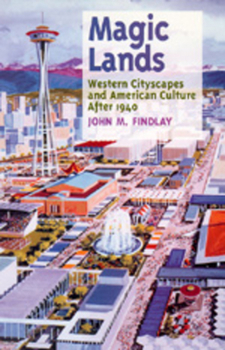Magic Lands: Western Cityscapes and American Culture After 1940
Select Format
Select Condition 
Book Overview
The American West conjures up images of pastoral tranquility and wide open spaces, but by 1970 the Far West was the most urbanized section of the country. Exploring four intriguing cityscapes-Disneyland, Stanford Industrial Park, Sun City, and the 1962 Seattle World's Fair-John Findlay shows how each created a sense of cohesion and sustained people's belief in their superior urban environment. This first book-length study of the urban West after 1940 argues that Westerners deliberately tried to build cities that differed radically from their eastern counterparts.
In 1954, Walt Disney began building the world's first theme park, using Hollywood's movie-making techniques. The creators of Stanford Industrial Park were more hesitant in their approach to a conceptually organized environment, but by the mid-1960s the Park was the nation's prototypical "research park" and the intellectual downtown for the high-technology region that became Silicon Valley.
In 1960, on the outskirts of Phoenix, Del E. Webb built Sun City, the largest, most influential retirement community in the United States. Another innovative cityscape arose from the 1962 Seattle World's Fair and provided a futuristic, somewhat fanciful vision of modern life.
These four became "magic lands" that provided an antidote to the apparent chaos of their respective urban milieus. Exemplars of a new lifestyle, they are landmarks on the changing cultural landscape of postwar America.
In 1954, Walt Disney began building the world's first theme park, using Hollywood's movie-making techniques. The creators of Stanford Industrial Park were more hesitant in their approach to a conceptually organized environment, but by the mid-1960s the Park was the nation's prototypical "research park" and the intellectual downtown for the high-technology region that became Silicon Valley.
In 1960, on the outskirts of Phoenix, Del E. Webb built Sun City, the largest, most influential retirement community in the United States. Another innovative cityscape arose from the 1962 Seattle World's Fair and provided a futuristic, somewhat fanciful vision of modern life.
These four became "magic lands" that provided an antidote to the apparent chaos of their respective urban milieus. Exemplars of a new lifestyle, they are landmarks on the changing cultural landscape of postwar America.
Format:Paperback
Language:English
ISBN:0520084357
ISBN13:9780520084353
Release Date:September 1993
Publisher:University of California Press
Length:394 Pages
Weight:1.49 lbs.
Dimensions:1.0" x 6.1" x 9.0"
Customer Reviews
2 ratings
An excellent urban history
Published by Thriftbooks.com User , 19 years ago
Americans have always looked west to reinvent themselves. This trend has been constant from the nation's inception throughout the twentieth-century. With this migration came growth in population and urbanization. In Magic Lands Author John M. Findlay argues that planned communities arose to offer alternatives to this unrelenting urbanization. To support his argument he presents four case studies of planned communities: California's Disneyland and Silicon Valley, Arizona's Sun City retirement community and grounds for the Seattle World's Fair. These "magic lands" were sources of recreation, inspiration and optimism for the rest of the country. Magic Lands begins with a look at the West's rapid growth at mid-century. Findlay credits the military spending of World War II and a post-war boom driven by the G.I. Bill for increasing populations and changing landscapes. New industries-such as Hewlett-Packard in Silicon Valley and Boeing in Seattle-aided this growth by driving the west to new economic heights. With new jobs came an increase in demand for housing and shopping plazas. The result was the "horizontal" urban community, one which sprawled outside of the urban center creating sprawl. Reacting to this eastern-style growth, westerners escaped to planned communities for amusement and alternatives to urban lifestyles. These alternative visions presented in Magic Lands vary drastically. Walt Disney envisioned Disneyland both as family entertainment and as his example as "the city of tomorrow". Stanford built an industrial center that relied on the surrounding natural geography and climate to draw its workforce. Conversely, Sun City severely altered its surroundings to provide an "ideal" active retirement community. And Seattle converted a run down neighborhood to house it's 1962 world's fair. In each case study, Findlay explores how these areas transformed their adjacent communities geographically, economically and culturally. But how these Magic Lands were constructed varied drastically. Disneyland was built under the close supervision of Walt Disney, who envisioned his planned community as an example for the entire country, but Stanford's Industrial Park (i.e. Silicon Valley) never had a master plan-simply a goal of building a high tech industrial center. In the case of Sun City, a drive for profit and little else led to the construction of this rich and green retirement community in the Arizona desert. Seattle's World Fair aimed to revitalize its downtown district-and failed. But in each case, the results of these communities influenced national ideas on architecture and urban landscapes. While Magic Lands does offer a compelling look at these four planned communities, their similarities are tenuous at best. Comparisons of Disneyland to the Seattle World's Fair are sometimes a stretch, while Sun City shares little in common with Seattle. These are vastly different and unique communities. More compelling is Findlay's f
Good History of Planned Communities
Published by Thriftbooks.com User , 21 years ago
Findlay has written an excellent book in urban history. He weaves theory into his narrative effortlessly with few exceptions. Those rare exceptions occur when he heavy-handedly repeats his message, but they are easily overlooked. He also masterfully uses the photographs to enhance his argument, though one wishes that he had included comparative maps to make the micro-communities "legible" to the reader. His argument was convincing overall and left one wishing that he could have treated just a couple more important western landmarks. His most important contribution is to help the reader understand how western cities evolved from eastern, nuclear conception of a city to a model akin to the solar system.






